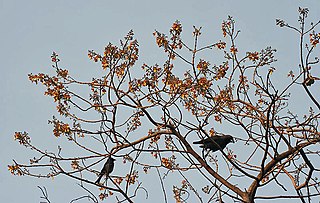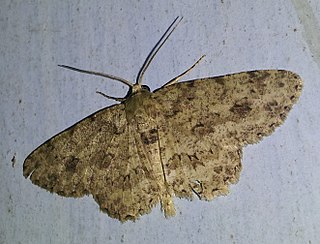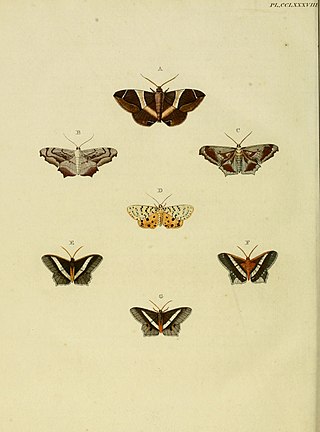
Gmelina is a genus of plants in the family Lamiaceae. It consists of about 35 species in Australia, New Guinea, New Caledonia, Southeast Asia, India and a few in Africa. Some species such as G. arborea have been planted and/or become naturalised in India, Africa and Australia. It was named by Carl Linnaeus in honour of botanist Johann Georg Gmelin.

Comostola is a genus of moths in the family Geometridae erected by Edward Meyrick in 1888. They are found primarily in Asia and Australia.

Ozola is a genus of moths in the family Geometridae first described by Francis Walker in 1861.
Pamphlebia is a monotypic moth genus in the family Geometridae described by Warren in 1897. Its only species, Pamphlebia rubrolimbraria, was first described by Achille Guenée in 1857. It is found in Sri Lanka, Borneo, Indonesia, Taiwan and Australia.

Sauris is a genus of moths in the family Geometridae erected by Achille Guenée in 1857.

Symmacra is a monotypic moth genus in the family Geometridae described by Warren in 1896. Its only species, Symmacra solidaria, was first described by Achille Guenée in 1858. It is found in Indo-Australian tropics of India, Sri Lanka, Borneo east to Fiji, Samoa and Australia.

Borbacha pardaria is a moth of the family Geometridae first described by Achille Guenée in 1857. It is found in India, Sundaland, Sulawesi and probably in Sri Lanka,

Ectropis bhurmitra, the tea twig caterpillar, is a moth of the family Geometridae. The species was first described by Francis Walker in 1860. A widespread Asian species, it is found around Indo-Australian tropics from India, Sri Lanka and Hong Kong, Taiwan, Thailand, New Guinea to Australian Queensland and the Solomon Islands.

Gonodontis clelia is a moth in the family Geometridae first described by Pieter Cramer in 1780. It is found in Sri Lanka, South India, Pakistan, Nepal, Hong Kong, the Andaman Islands, Singapore, Borneo and Australia.

Hypomecis transcissa is a moth of the family Geometridae first described by Francis Walker in 1860. It is found in the Indian subregion and from Sri Lanka to Sundaland.
Luxiaria phyllosaria is a moth of the family Geometridae first described by Francis Walker in 1860. It is found in Sri Lanka, the north-eastern Himalayas of India, Sumatra, Borneo, the Philippines and Sulawesi.
Ozola microniaria is a moth of the family Geometridae first described by Francis Walker in 1862. It is found in Sri Lanka.
Pelagodes clarifimbria is a moth of the family Geometridae first described by Prout in 1919. It is found in Sri Lanka, Peninsular Malaysia and Borneo.
Scardamia metallaria is a moth of the family Geometridae first described by Achille Guenée in 1858. It is found in Sri Lanka, India and Australia.
Scardamia bractearia is a moth of the family Geometridae first described by Francis Walker in 1860. It is found in Sri Lanka.

Spaniocentra pannosa is a moth of the family Geometridae first described by Frederic Moore in 1887. It is found in Sri Lanka.
Zamarada baliata is a moth of the family Geometridae first described by Felder in 1874. It is found in Sundaland and most likely in India and Sri Lanka.
Sauris lineosa is a moth of the family Geometridae first described by Frederic Moore in 1888. It is found in India and Sri Lanka.

Sauris interruptata is a moth of the family Geometridae first described by Frederic Moore in 1888. It is found in India's north-east Himalayas, Sri Lanka, the Ryukyu Islands, Taiwan, Myanmar, Peninsular Malaysia, Borneo, the Philippines, and possibly the Moluccas and New Guinea.
Selepa celtis, called the hairy caterpillar as a larva, is a moth of the family Nolidae. The species was first described by Frederic Moore in 1858. It is found in Oriental tropics of India, Sri Lanka, Taiwan towards the Ryukyu Islands and Australia.










